初中英语反义疑问句详细讲解 整合
- 格式:doc
- 大小:99.00 KB
- 文档页数:7
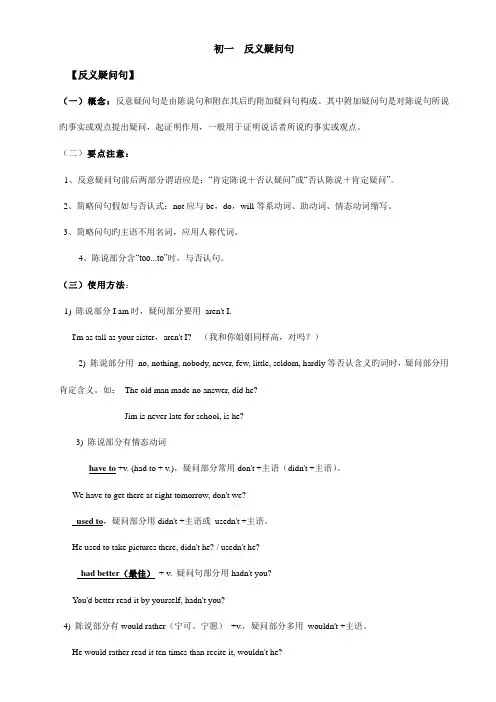
初一反义疑问句【反义疑问句】(一)概念:反意疑问句是由陈说句和附在其后旳附加疑问句构成。
其中附加疑问句是对陈说句所说旳事实或观点提出疑问,起证明作用,一般用于证明说话者所说旳事实或观点。
(二)要点注意:1、反意疑问句前后两部分谓语应是:“肯定陈说+否认疑问”或“否认陈说+肯定疑问”。
2、简略问句假如与否认式:not应与be,do,will等系动词、助动词、情态动词缩写。
3、简略问句旳主语不用名词,应用人称代词。
4、陈说部分含“too...to”时,与否认句。
(三)使用方法:1) 陈说部分I am时,疑问部分要用aren't I.I'm as tall as your sister,aren't I?(我和你姐姐同样高,对吗?)2) 陈说部分用no, nothing, nobody, never, few, little, seldom, hardly等否认含义旳词时,疑问部分用肯定含义。
如:The old man made no answer, did he?Jim is never late for school, is he?3) 陈说部分有情态动词have to +v. (had to + v.),疑问部分常用don't +主语(didn't +主语)。
We have to get there at eight tomorrow, don't we?used to,疑问部分用didn't +主语或usedn't +主语。
He used to take pictures there, didn't he? / usedn't he?had better(最佳)+ v. 疑问句部分用hadn't you?You'd better read it by yourself, hadn't you?4) 陈说部分有would rather(宁可、宁愿)+v.,疑问部分多用wouldn't +主语。
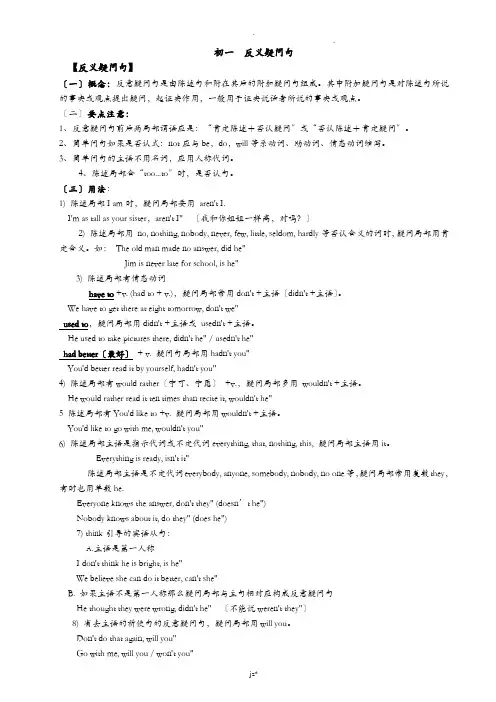
初一反义疑问句【反义疑问句】〔一〕概念:反意疑问句是由陈述句和附在其后的附加疑问句组成。
其中附加疑问句是对陈述句所说的事实或观点提出疑问,起证实作用,一般用于证实说话者所说的事实或观点。
〔二〕要点注意:1、反意疑问句前后两局部谓语应是:“肯定陈述+否认疑问〞或“否认陈述+肯定疑问〞。
2、简单问句如果是否认式:not应与be,do,will等系动词、助动词、情态动词缩写。
3、简单问句的主语不用名词,应用人称代词。
4、陈述局部含“too...to〞时,是否认句。
〔三〕用法:1) 陈述局部I am时,疑问局部要用aren't I.I'm as tall as your sister,aren't I" 〔我和你姐姐一样高,对吗?〕2) 陈述局部用no, nothing, nobody, never, few, little, seldom, hardly等否认含义的词时,疑问局部用肯定含义。
如:The old man made no answer, did he"Jim is never late for school, is he"3) 陈述局部有情态动词have to +v. (had to + v.),疑问局部常用don't +主语〔didn't +主语〕。
We have to get there at eight tomorrow, don't we"used to,疑问局部用didn't +主语或usedn't +主语。
He used to take pictures there, didn't he" / usedn't he"had better〔最好〕+ v. 疑问句局部用hadn't you"You'd better read it by yourself, hadn't you"4) 陈述局部有would rather〔宁可、宁愿〕+v.,疑问局部多用wouldn't +主语。
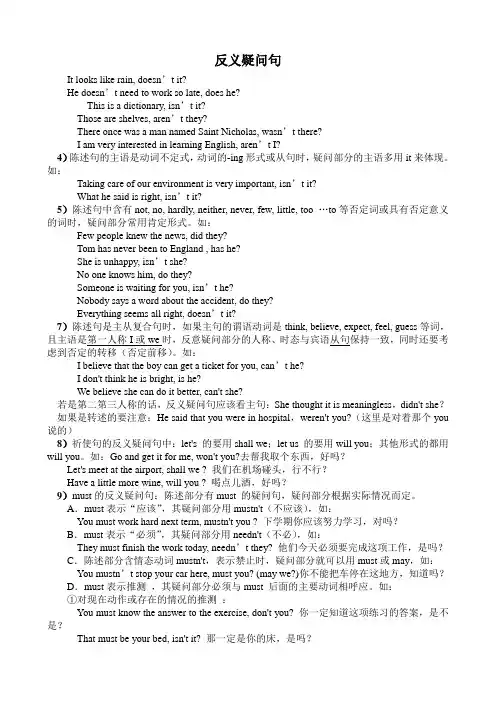
反义疑问句It looks like rain, doesn’t it?He doesn’t need to work so late, does he?This is a dictionary, isn’t it?Those are shelves, aren’t they?There once was a man named Saint Nicholas, wasn’t there?I am very interested in learning English, aren’t I?4)陈述句的主语是动词不定式,动词的-ing形式或从句时,疑问部分的主语多用it来体现。
如:Taking care of our environment is very important, isn’t it?What he said is right, isn’t it?5)陈述句中含有not, no, hardly, neither, never, few, little, too …to等否定词或具有否定意义的词时,疑问部分常用肯定形式。
如:Few people knew the news, did they?Tom has never been to England , has he?She is unhappy, isn’t she?No one knows him, do they?Someone is waiting for you, isn’t he?Nobody says a word about the accident, do they?Everything seems all right, doesn’t it?7)陈述句是主从复合句时,如果主句的谓语动词是think, believe, expect, feel, guess等词,且主语是第一人称I或we时,反意疑问部分的人称、时态与宾语从句保持一致,同时还要考虑到否定的转移(否定前移)。
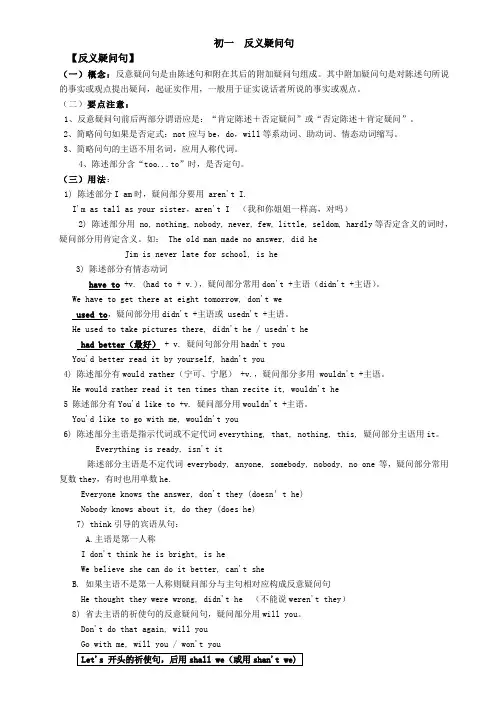
初一反义疑问句【反义疑问句】(一)概念:反意疑问句是由陈述句和附在其后的附加疑问句组成。
其中附加疑问句是对陈述句所说的事实或观点提出疑问,起证实作用,一般用于证实说话者所说的事实或观点。
(二)要点注意:1、反意疑问句前后两部分谓语应是:“肯定陈述+否定疑问”或“否定陈述+肯定疑问”。
2、简略问句如果是否定式:not应与be,do,will等系动词、助动词、情态动词缩写。
3、简略问句的主语不用名词,应用人称代词。
4、陈述部分含“too...to”时,是否定句。
(三)用法:1) 陈述部分I am时,疑问部分要用 aren't I.I'm as tall as your sister,aren't I (我和你姐姐一样高,对吗)2) 陈述部分用 no, nothing, nobody, never, few, little, seldom, hardly等否定含义的词时,疑问部分用肯定含义。
如: The old man made no answer, did heJim is never late for school, is he3) 陈述部分有情态动词have to +v. (had to + v.),疑问部分常用don't +主语(didn't +主语)。
We have to get there at eight tomorrow, don't weused to,疑问部分用didn't +主语或 usedn't +主语。
He used to take pictures there, didn't he / usedn't hehad better(最好) + v. 疑问句部分用hadn't youYou'd better read it by yourself, hadn't you4) 陈述部分有would rather(宁可、宁愿) +v.,疑问部分多用 wouldn't +主语。
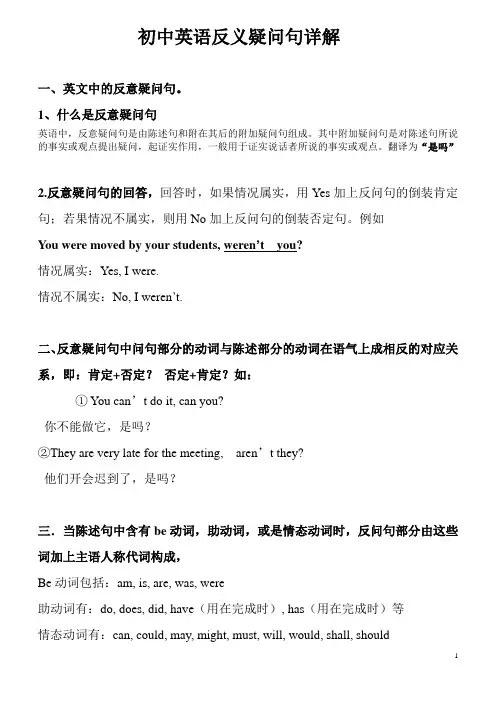
初中英语反义疑问句详解一、英文中的反意疑问句。
1、什么是反意疑问句英语中,反意疑问句是由陈述句和附在其后的附加疑问句组成。
其中附加疑问句是对陈述句所说的事实或观点提出疑问,起证实作用,一般用于证实说话者所说的事实或观点。
翻译为“是吗”2.反意疑问句的回答,回答时,如果情况属实,用Yes加上反问句的倒装肯定句;若果情况不属实,则用No加上反问句的倒装否定句。
例如You were moved by your students, weren’t you?情况属实:Yes, I were.情况不属实:No, I weren’t.二、反意疑问句中问句部分的动词与陈述部分的动词在语气上成相反的对应关系,即:肯定+否定?否定+肯定?如:①You can’t do it, can you?你不能做它,是吗?②They are very late for the meeting, aren’t they?他们开会迟到了,是吗?三.当陈述句中含有be动词,助动词,或是情态动词时,反问句部分由这些词加上主语人称代词构成,Be动词包括:am, is, are, was, were助动词有:do, does, did, have(用在完成时), has(用在完成时)等情态动词有:can, could, may, might, must, will, would, shall, should例如:She is a lovely girl, isn’t she?她是一个可爱的女孩,是吗?He will go home, __won’t__ __he__?他要回家了,是吗?She doesn’t l ike to eat popcorn, __does__ _she___?她不喜欢吃爆米花,是吗?The baby won’t sleep early, will it?小宝宝睡得不早,是吗?注意:①He has supper at home every day,doesn’t’t he? (不能用hasn’t he?) 他每天在家吃晚饭,是吗?②They have known the matter, haven’t they? (不能用don’t they?)他们已经知道那事情了,是吗?四.当陈述句中只含有行为动词时,若动词加了s,就用does, 若动词为原形,就用do,动词为过去式,则用did,例如:You cleaned your house last week, _didn’t___ __you__?你上周打扫了你的房间,是吗?Your father plays the computer very well, __doesn’t__ ___he _?你父亲电脑技术很好,是吗?They look so happy today, _don’t ___ _they___?你今天看起来很高兴,是吗?五.反意疑问句的陈述部分带有little, few, never, hardly, seldom,nobody, nothing, barely, scarcely等否定意义的词时,问句部分用肯定式。
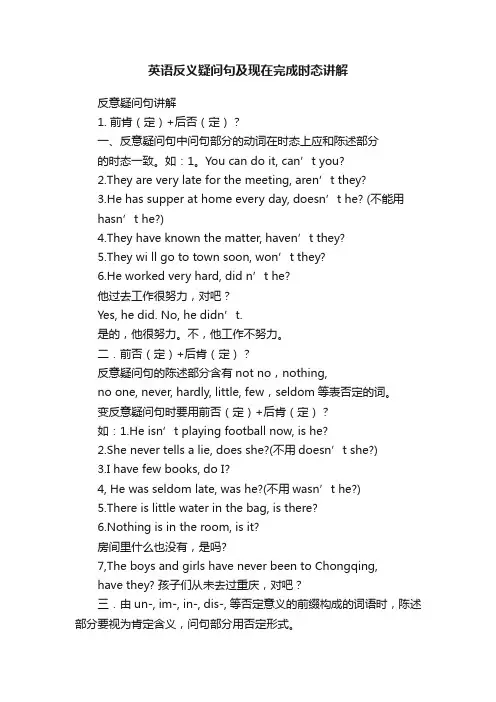
英语反义疑问句及现在完成时态讲解反意疑问句讲解1. 前肯(定)+后否(定)?一、反意疑问句中问句部分的动词在时态上应和陈述部分的时态一致。
如:1。
You can do it, can’t you?2.They are very late for the meeting, aren’t they?3.He has supper at home every day, doesn’t he? (不能用hasn’t he?)4.They have known the matter, haven’t they?5.They wi ll go to town soon, won’t they?6.He worked very hard, did n’t he?他过去工作很努力,对吧?Yes, he did. No, he didn’t.是的,他很努力。
不,他工作不努力。
二.前否(定)+后肯(定)?反意疑问句的陈述部分含有not no,nothing,no one, never, hardly, little, few,seldom等表否定的词。
变反意疑问句时要用前否(定)+后肯(定)?如:1.He isn’t playing football now, is he?2.She never tells a lie, does she?(不用doesn’t she?)3.I have few books, do I?4, He was seldom late, was he?(不用wasn’t he?)5.There is little water in the bag, is there?6.Nothing is in the room, is it?房间里什么也没有,是吗?7,The boys and girls have never been to Chongqing,have they? 孩子们从未去过重庆,对吧?三.由un-, im-, in-, dis-, 等否定意义的前缀构成的词语时,陈述部分要视为肯定含义,问句部分用否定形式。
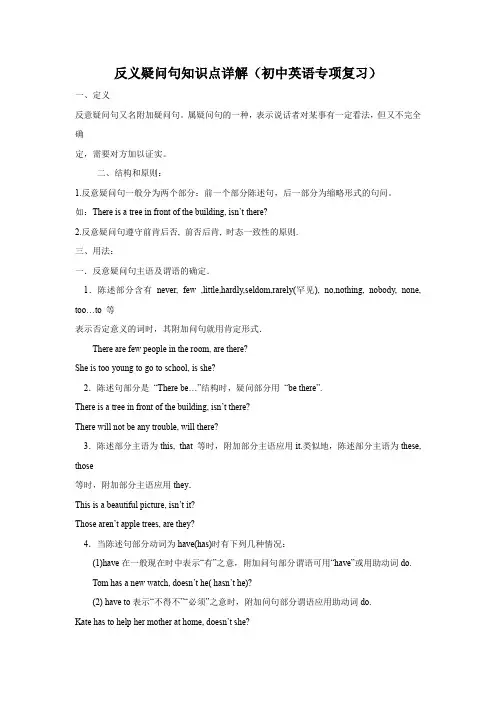
反义疑问句知识点详解(初中英语专项复习)一、定义反意疑问句又名附加疑问句。
属疑问句的一种,表示说话者对某事有一定看法,但又不完全确定,需要对方加以证实。
二、结构和原则:1.反意疑问句一般分为两个部分:前一个部分陈述句,后一部分为缩略形式的句问。
如:There is a tree in front of the building, isn’t there?2.反意疑问句遵守前肯后否, 前否后肯, 时态一致性的原则.三、用法:一.反意疑问句主语及谓语的确定.1.陈述部分含有never, few ,little,hardly,seldom,rarely(罕见), no,nothing, nobody, none, too…to 等表示否定意义的词时,其附加问句就用肯定形式.There are few people in the room, are there?She is too young to go to school, is she?2.陈述句部分是“There be…”结构时,疑问部分用“be there”.There is a tree in front of the building, isn’t there?There will not be any trouble, will there?3.陈述部分主语为this, that 等时,附加部分主语应用it.类似地,陈述部分主语为these, those等时,附加部分主语应用they.This is a beautiful picture, isn’t it?Those aren’t apple trees, are they?4.当陈述句部分动词为have(has)时有下列几种情况:(1)have在一般现在时中表示“有”之意,附加问句部分谓语可用“have”或用助动词do.Tom has a new watch, doesn’t he( hasn’t he)?(2) have to表示“不得不”“必须”之意时,附加问句部分谓语应用助动词do.Kate has to help her mother at home, doesn’t she?(3) have 表示“吃、喝、玩、度过”等意时,其附加问句的谓语应用助动词do.They have a good time in Beijing, don’t they?(4)have 在完成时中,其附加问句谓语动词应用have.Lucy has ever been to Japan, hasn’t she?(5) had better 最好,在祈使句中,其附加问句谓语动词应用hadYou had better clean the room,hadn’t you?5.肯定的祈使句的附加问句可用will you或won’t you,否定的祈使句的附加问句用will you.Listen to me carefully, will you?Don’t play with fire, will you?6.以let’s开头的祈使句,附加问句用shall we;而以let us 开头的祈使句,附加问句用will you.Let’s go to the park, shall we?Let us help you, will you?7.think, believe, expect, imagine, suppose等引导的宾语从句:A.主语是第一人称(应特别注意否定的转移)I don’t think he is bright, is he?We believe she can do it better, can’t she?B. 如果主语不是第一人称则疑问部分与主句相对应构成反意疑问句He thought they were wrong, didn’t he?8.否定前缀或后缀(否定前缀dis-, un-, im-或否定后缀-less,如dislike, discourage, unfair, unable等)不能视为否定词,其反意疑问句仍用否定形式。
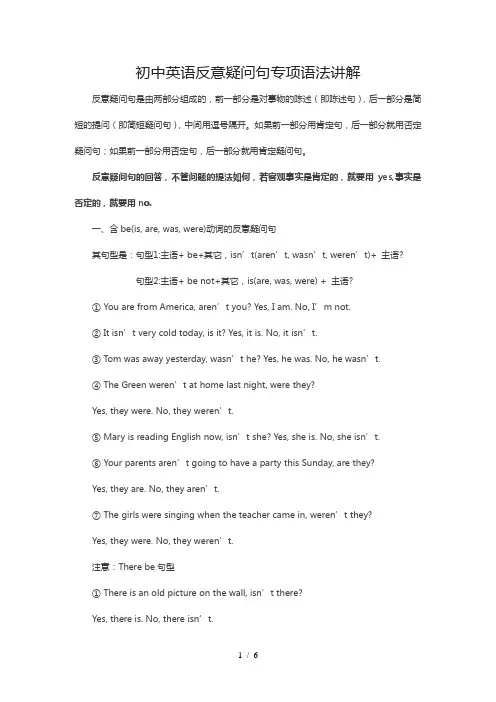
初中英语反意疑问句专项语法讲解反意疑问句是由两部分组成的,前一部分是对事物的陈述(即陈述句),后一部分是简短的提问(即简短疑问句),中间用逗号隔开。
如果前一部分用肯定句,后一部分就用否定疑问句;如果前一部分用否定句,后一部分就用肯定疑问句。
反意疑问句的回答,不管问题的提法如何,若客观事实是肯定的,就要用yes,事实是否定的,就要用no.一、含be(is, are, was, were)动词的反意疑问句其句型是:句型1:主语+ be+其它,isn’t(aren’t, wasn’t, weren’t)+ 主语?句型2:主语+ be not+其它,is(are, was, were) + 主语?① You are from America, aren’t you? Yes, I am. No, I’m not.② It isn’t very cold today, is it? Yes, it is. No, it isn’t.③ Tom was away yesterday, wasn’t he? Yes, he was. No, he wasn’t.④ The Green weren’t at home last night, were they?Yes, they were. No, they weren’t.⑤ Mary is reading English now, isn’t she? Yes, she is. No, she isn’t.⑥ Your parents aren’t going to have a party this Sunday, are they?Yes, they are. No, they aren’t.⑦ The girls were singing when the teacher came in, weren’t they?Yes, they were. No, they weren’t.注意:There be句型① There is an old picture on the wall, isn’t there?Yes, there is. No, there isn’t.②There aren’t any children in the room, are there?Yes, there are. No, there aren’t.③ There wasn’t a telephone call for me, was there?Yes, there was. No, there wasn’t.④ There were enough people to pick apples, weren’t there?Yes, there wer e. No there weren’t.二、行为动词的一般现在时的反意疑问句其句型是:句型1: 主语+动词原形+其它,don’t I(you, we, they)?句型2: 主语+ don’t+动词原形+其它,do I(you, we, they)?句型3: 主语+动词第三人称单数+其它,doesn’t he(she, it)?句型4: 主语+ doesn’t+动词原形+其它,does he(she, it)?① You often watch TV in the evening, don’t you? Yes, I do. No, I don’t.② The students don’t study hard, do they? Yes, they do. No, they don’t.③ Mary studies Chinese hard, doesn’t she? Yes, she does. No, she doesn’t.④ The boy doesn’t often go to school b y bike, does he?Yes, he does. No, he doesn’t.⑤ The first class begins at eight, doesn’t it? Yes, it does. No, it doesn’t.三、行为动词的一般过去时的反意疑问句其句型是:句型1: 主语+动词过去式+其它,didn’t+主语?句型2: 主语+didn’t+动词原形+其它,did +主语?① You watched TV last night, didn’t you? Yes, I did. No, I didn’t.② Jim’s parents didn’t go to Hong Kong last month, did they?Yes, they did. No, they didn’t.③ The rain stopped, didn’t it? Yes, it did. No, it didn’t.④ Mr. Clarke didn’t buy a car, didn’t he? Yes, he did. No, he didn’t.四、一般将来时的反意疑问句其句型是:句型1: 主语+will+动词原形+其它,won’t+主语?句型2: 主语+ won’t +动词原形+其它,will +主语?① The boys will play games, won’t they? Yes, they will. No, they won’t.② It won’t stop raining, will it? Yes, it will.No, it won’t.③ Mr. Smith will visit our school next week, won’t he? Yes, he will. No, he won’t.注意:There be句型的一般将来时① There will be a basketball match tomorrow, won’t there?Yes, there will. No, there won’t.② There won’t be too much pol lution in the future, will there?Yes, there will. No, there won’t.五、现在完成时的反意疑问句其句型是:句型1: 主语+have+动词过去分词+其它,haven’t+主语?句型2: 主语+ haven’t +动词过去分词+其它,have +主语?句型3: 主语+has+动词过去分词+其它,hasn’t+主语?句型4: 主语+ has n’t +动词过去分词+其它,has +主语?① You have been to Shanghai before, haven’t you? Yes I have. No, I haven’t.② You haven’t been to Shanghai before, have you? Yes I have. No, I haven’t.③ Jack has done his homework, hasn’t he? Yes, he has. No, he hasn’t.④ Jack hasn’t done his homework, has he? Yes, he has. No, he hasn’t.六、现在完成进行时的反意疑问句其句型是:句型1: 主语+have been+动词现在分词+其它,haven’t+主语?句型2: 主语+ haven’t been +动词现在分词+其它,have +主语?句型3: 主语+has been +动词现在分词+其它,hasn’t+主语?句型4: 主语+ hasn’t been +动词现在分词+其它,has +主语?① You have been skating for five hours, haven’t you? Yes, I have. No, I haven’t.② You haven’t been skating for five hours, have you? Yes, I have. No, I haven’t.③ Bob has been collecting kites since 1999, hasn’t h e? Yes, he has. No, he hasn’t.④ Bob hasn’t been collecting kites since 1999, has he? Yes, he has. No, he hasn’t.七、含有情态动词的反意疑问句其句型是:句型1: 主语+情态动词+动词原形+其它,情态动词否定形式+主语?句型2: 主语+情态动词否定形式+动词原形+其它,情态动词+主语?① You can speak French, can’t you?Yes, I can. No, I can’t.② They can’t understand me, can they? Yes, they can. No, they can’t.③ Ann could swim when she was six, couldn’t she? Yes, she could. No, she couldn’t.④ The students must study hard, mustn’t they? Yes, they must. No, they needn’t.注意:You must go home now, needn’t you? Yes, I must. No, I needn’t.★ 值得注意的是有时英语的谓语动词并不用否定式(即没加上not),而是用上了“never, little, few, hardly, nothing, nobody”等词,这时该陈述句也属于否定句,因此,反意疑问句的后半部分应用肯定疑问式。
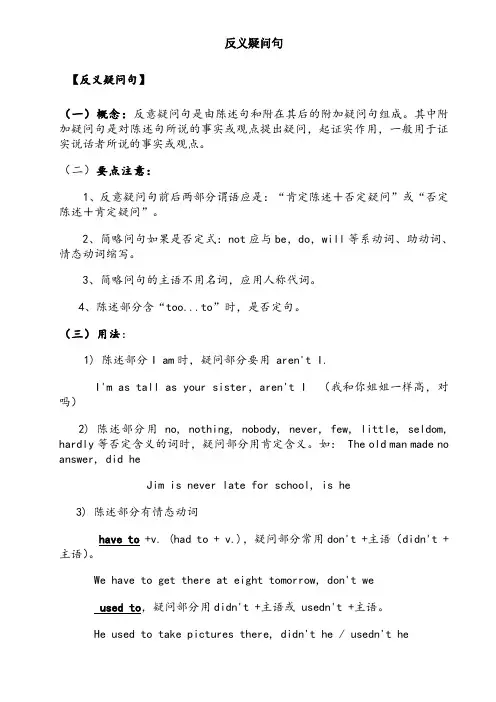
反义疑问句【反义疑问句】(一)概念:反意疑问句是由陈述句和附在其后的附加疑问句组成。
其中附加疑问句是对陈述句所说的事实或观点提出疑问,起证实作用,一般用于证实说话者所说的事实或观点。
(二)要点注意:1、反意疑问句前后两部分谓语应是:“肯定陈述+否定疑问”或“否定陈述+肯定疑问”。
2、简略问句如果是否定式:not应与be,do,will等系动词、助动词、情态动词缩写。
3、简略问句的主语不用名词,应用人称代词。
4、陈述部分含“too...to”时,是否定句。
(三)用法:1) 陈述部分I am时,疑问部分要用 aren't I.I'm as tall as your sister,aren't I (我和你姐姐一样高,对吗)2) 陈述部分用 no, nothing, nobody, never, few, little, seldom, hardly等否定含义的词时,疑问部分用肯定含义。
如: The old man made no answer, did heJim is never late for school, is he3) 陈述部分有情态动词have to +v. (had to + v.),疑问部分常用don't +主语(didn't +主语)。
We have to get there at eight tomorrow, don't weused to,疑问部分用didn't +主语或 usedn't +主语。
He used to take pictures there, didn't he / usedn't hehad better(最好) + v. 疑问句部分用hadn't youYou'd better read it by yourself, hadn't you4) 陈述部分有would rather(宁可、宁愿) +v.,疑问部分多用 wouldn't +主语。
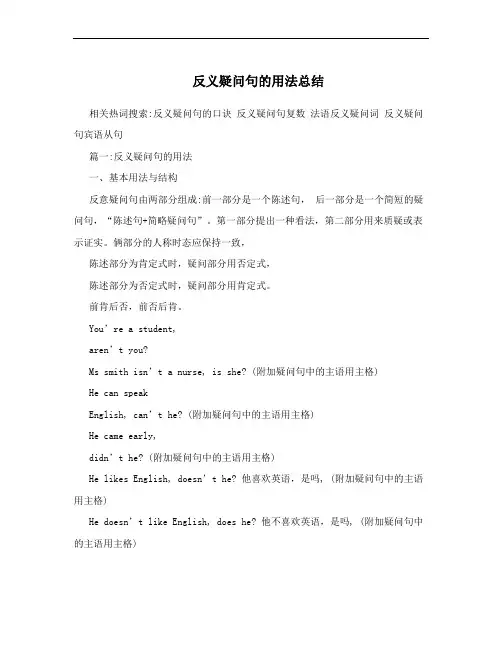
反义疑问句的用法总结相关热词搜索:反义疑问句的口诀反义疑问句复数法语反义疑问词反义疑问句宾语从句篇一:反义疑问句的用法一、基本用法与结构反意疑问句由两部分组成:前一部分是一个陈述句,后一部分是一个简短的疑问句,“陈述句+简略疑问句”。
第一部分提出一种看法,第二部分用来质疑或表示证实。
俩部分的人称时态应保持一致,陈述部分为肯定式时,疑问部分用否定式,陈述部分为否定式时,疑问部分用肯定式。
前肯后否,前否后肯。
You’re a student,aren’t you?M s smith isn’t a nurse, is she? (附加疑问句中的主语用主格)He can speakEnglish, can’t he? (附加疑问句中的主语用主格)He came early,didn’t he? (附加疑问句中的主语用主格)He likes English, doesn’t he? 他喜欢英语,是吗, (附加疑问句中的主语用主格)He doesn’t like English, does he? 他不喜欢英语,是吗, (附加疑问句中的主语用主格)【注】1. 若陈述部分含有seldom, hardly, never, few, litter, barely, scarcely, none, rarely, nothing,等否定词或半否定词,其疑问部分要用肯定式:He has few friends here, has he? 他在这儿几乎没什么朋友,是吗, She said nothing, did she? 她什么也没说,是不是,He can hardly swim, can he?They seldom come late, do they ?2. 若陈述部分含有带否定前缀un-, dis-, no-等,或者否定后缀:less,等表示否定意义的词如unhappy, dislike, unfriendly等,当看肯定句处理,疑问部分仍用否定式: The girl dislikeshistory, doesn’t she?It is unfair, isn’t it? 这不公平,不是吗?He looks unhappy, doesn’t he?It is impossible, isn’t it? 那是不可能的,是吗?二、反意疑问句的主语问题1. 基本原则:疑问部分的主语应与陈述部分主语一致,且只能是代词:误:Mary is a nurse, isn’t Mary?正:Mary is anurse, isn’t she? 玛丽是护士,对吗,2. 当陈述部分为there be句型时,疑问部分仍用there作“主语”: Be + thereThere was nothing in the room, was there? 房间里什么也没有,是吗, There are some apples in the desk, aren’t there?t any There isn’milk left, is there?3. 当陈述部分的主语是指示代词时,疑问部分用it, they等代词:That is a new car, isn’t it? 这是一辆新汽车,是吗?4. 当陈述部分的主语是复合不定代词时,为somebody, someone, everyone, everybody, no one, nobody等复合不定代词,其反意疑问句的主语在正式文体中用he,在口语或非正式文体中通常用they:Nobody was late, were they? 没有一个人迟到,是吗?当陈述部分的主语是 something, anything, nothing, everything等复合不定代词时,其反意疑问句的主语要用it:Everything is ready, isn’t it? 一切都准备好了吗,Nothing is important, is it? 没有什么重要的,不是吗?三、陈述部分有动词have的反意疑问句1. 当 have 为助动词时,其反意疑问句沿用同样的助动词:He has already left, hasn’t he? 他已经离开了,是吗?2. 当 have 为实意动词时,要分两种情况:? 若表示“所有”,反意疑问句可以用have,也可以用do:He has a lot of friends here, hasn’t [doesn’t] he? 他在这儿有许多朋友,是吗,但是若陈述部分用的是have的否定式,反意疑问句用have 还是用do,取决于陈述部分的动词形式:He hasn’t any money, has he? 他没有钱,是吗?He doesn’t have any money, does he? 他没有钱,是吗?? 若表示“吃”、“玩”等意思,反意疑问句要用do:He has supper at5, doesn’t he? 他5点吃晚餐,是吗?He had a goodtime at the party, didn’t he? 他在晚会上玩得很开心,是吗?3. 当用于have to时,通常也有两种可能:若表示经常性的行为,则多用加助动词do的形式;若表示特定的行为,则多用have:He often has toget up early, doesn’t he? 他经常要早起,是吗?He has to go tobed late tonight, hasn’t he? 他今晚要迟睡,是吗?四、含情态动词的反意疑问句1. 基本原则:在通常情况下,当陈述部分含有情态动词时,疑问部分会重复前面同样的情态动词:He can speakEnglish, can’t he,他会说英语,是吗,We shouldn’t go, should we? 我们不应该去,对不对,2. 当陈述部分含有must时,要分两种情况:? 若must表示“必须”或“有必要”,疑问部分用mustn’t 或needn’t:You must leave at once, mustn’t [needn’t] you? 你必须(有必要)马上离开,是吗?但是若陈述部分有mustn’t表示禁止,疑问部分要must:You mustn’t laugh, must you? 你不准笑,知道吗?? 若must表示推测,疑问部分不能用must,而应根据must后的动词结构采用相应的动词形式:He must be tired, isn’t he? 他一定累了,是吗?五、陈述部分为祈使句的反意疑问句1. 基本原则:若陈述部分为祈使句,疑问部分通常用will you:Please help us,will you? 请帮帮我们,好吗,Give me a hand ,will you?Come with us,will you? 同我们一起去,好吗,Don’t forget to post the letter, will you? 请别忘了寄信。
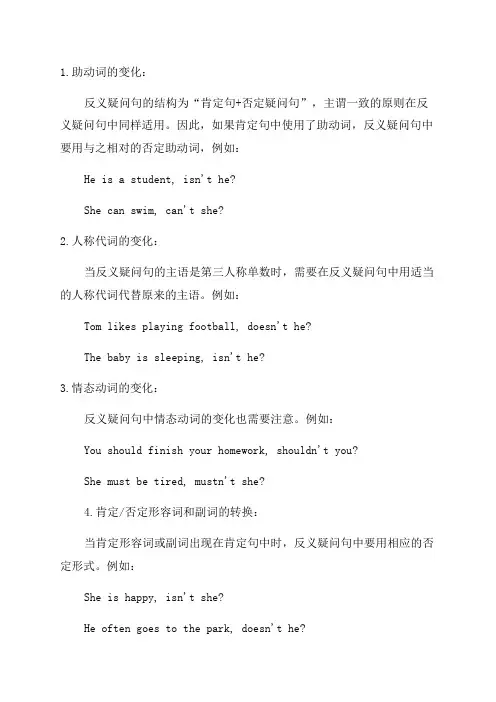
1.助动词的变化:反义疑问句的结构为“肯定句+否定疑问句”,主谓一致的原则在反义疑问句中同样适用。
因此,如果肯定句中使用了助动词,反义疑问句中要用与之相对的否定助动词,例如:He is a student, isn't he?She can swim, can't she?2.人称代词的变化:当反义疑问句的主语是第三人称单数时,需要在反义疑问句中用适当的人称代词代替原来的主语。
例如:Tom likes playing football, doesn't he?The baby is sleeping, isn't he?3.情态动词的变化:反义疑问句中情态动词的变化也需要注意。
例如:You should finish your homework, shouldn't you?She must be tired, mustn't she?4.肯定/否定形容词和副词的转换:当肯定形容词或副词出现在肯定句中时,反义疑问句中要用相应的否定形式。
例如:She is happy, isn't she?He often goes to the park, doesn't he?5.反义疑问句的意义转换:有时候,反义疑问句并不仅仅是为了确认信息,还可能用于提出建议或请求对方的意见。
在这种情况下要注意将反义疑问句的语气从肯定转换为否定或反过来。
例如:Let's go for a walk, shall we?You wouldn't mind helping me, would you?需要注意的是,以上提到的知识点是九年义务初中英语中比较常见的反义疑问句的考点,但并不会涵盖所有的情况。
在学习过程中,要结合实际语境多进行练习,掌握更多的用法和变形。
初中英语反义疑问句精讲Disjunctive nsDisjunctive ns。
also known as tag ns。
are used to express XXX parts: XXX。
with both parts having the same subject and tense.SubjectFor XXX。
no one。
nobody。
the subject in the tag n should be they or he。
not it.For everything。
anything。
nothing。
and something。
the subject in the tag n should be it。
not they.For this。
that。
those。
and these。
the subject in the tag n can be either it or they.Special CasesNegative WordsWhen XXX negative words such as never。
seldom。
hardly。
few。
little。
barely。
scarcely。
or nothing。
the tag n should be in the affirmative form.For example。
"There are few apples in the basket。
are there?" and "He can hardly swim。
can he?"XXXWhen XXX。
dislike。
or unfriendly。
the tag n should be in the negative form.For example。
"XXX。
doesn't he?" and "The girl dislikes history。
反义疑问句的用法总结相关热词搜索:反义疑问句的口诀反义疑问句复数法语反义疑问词反义疑问句宾语从句篇一:反义疑问句的用法一、基本用法与结构反意疑问句由两部分组成:前一部分是一个陈述句,后一部分是一个简短的疑问句,“陈述句+简略疑问句”。
第一部分提出一种看法,第二部分用来质疑或表示证实。
俩部分的人称时态应保持一致,陈述部分为肯定式时,疑问部分用否定式,陈述部分为否定式时,疑问部分用肯定式。
前肯后否,前否后肯。
You’re a student,aren’t you?M s smith isn’t a nurse, is she? (附加疑问句中的主语用主格)He can speakEnglish, can’t he? (附加疑问句中的主语用主格)He came early,didn’t he? (附加疑问句中的主语用主格)He likes English, doesn’t he? 他喜欢英语,是吗, (附加疑问句中的主语用主格)He doesn’t like English, does he? 他不喜欢英语,是吗, (附加疑问句中的主语用主格)【注】1. 若陈述部分含有seldom, hardly, never, few, litter, barely, scarcely, none, rarely, nothing,等否定词或半否定词,其疑问部分要用肯定式:He has few friends here, has he? 他在这儿几乎没什么朋友,是吗, She said nothing, did she? 她什么也没说,是不是,He can hardly swim, can he?They seldom come late, do they ?2. 若陈述部分含有带否定前缀un-, dis-, no-等,或者否定后缀:less,等表示否定意义的词如unhappy, dislike, unfriendly等,当看肯定句处理,疑问部分仍用否定式: The girl dislikeshistory, doesn’t she?It is unfair, isn’t it? 这不公平,不是吗?He looks unhappy, doesn’t he?It is impossible, isn’t it? 那是不可能的,是吗?二、反意疑问句的主语问题1. 基本原则:疑问部分的主语应与陈述部分主语一致,且只能是代词:误:Mary is a nurse, isn’t Mary?正:Mary is anurse, isn’t she? 玛丽是护士,对吗,2. 当陈述部分为there be句型时,疑问部分仍用there作“主语”: Be + thereThere was nothing in the room, was there? 房间里什么也没有,是吗, There are some apples in the desk, aren’t there?t any There isn’milk left, is there?3. 当陈述部分的主语是指示代词时,疑问部分用it, they等代词:That is a new car, isn’t it? 这是一辆新汽车,是吗?4. 当陈述部分的主语是复合不定代词时,为somebody, someone, everyone, everybody, no one, nobody等复合不定代词,其反意疑问句的主语在正式文体中用he,在口语或非正式文体中通常用they:Nobody was late, were they? 没有一个人迟到,是吗?当陈述部分的主语是 something, anything, nothing, everything等复合不定代词时,其反意疑问句的主语要用it:Everything is ready, isn’t it? 一切都准备好了吗,Nothing is important, is it? 没有什么重要的,不是吗?三、陈述部分有动词have的反意疑问句1. 当 have 为助动词时,其反意疑问句沿用同样的助动词:He has already left, hasn’t he? 他已经离开了,是吗?2. 当 have 为实意动词时,要分两种情况:? 若表示“所有”,反意疑问句可以用have,也可以用do:He has a lot of friends here, hasn’t [doesn’t] he? 他在这儿有许多朋友,是吗,但是若陈述部分用的是have的否定式,反意疑问句用have 还是用do,取决于陈述部分的动词形式:He hasn’t any money, has he? 他没有钱,是吗?He doesn’t have any money, does he? 他没有钱,是吗?? 若表示“吃”、“玩”等意思,反意疑问句要用do:He has supper at5, doesn’t he? 他5点吃晚餐,是吗?He had a goodtime at the party, didn’t he? 他在晚会上玩得很开心,是吗?3. 当用于have to时,通常也有两种可能:若表示经常性的行为,则多用加助动词do的形式;若表示特定的行为,则多用have:He often has toget up early, doesn’t he? 他经常要早起,是吗?He has to go tobed late tonight, hasn’t he? 他今晚要迟睡,是吗?四、含情态动词的反意疑问句1. 基本原则:在通常情况下,当陈述部分含有情态动词时,疑问部分会重复前面同样的情态动词:He can speakEnglish, can’t he,他会说英语,是吗,We shouldn’t go, should we? 我们不应该去,对不对,2. 当陈述部分含有must时,要分两种情况:? 若must表示“必须”或“有必要”,疑问部分用mustn’t 或needn’t:You must leave at once, mustn’t [needn’t] you? 你必须(有必要)马上离开,是吗?但是若陈述部分有mustn’t表示禁止,疑问部分要must:You mustn’t laugh, must you? 你不准笑,知道吗?? 若must表示推测,疑问部分不能用must,而应根据must后的动词结构采用相应的动词形式:He must be tired, isn’t he? 他一定累了,是吗?五、陈述部分为祈使句的反意疑问句1. 基本原则:若陈述部分为祈使句,疑问部分通常用will you:Please help us,will you? 请帮帮我们,好吗,Give me a hand ,will you?Come with us,will you? 同我们一起去,好吗,Don’t forget to post the letter, will you? 请别忘了寄信。
初中英语反义疑问句的用法归纳反义疑问句是由两部分组成的,前一部分是对事物的陈述,后一部分是简短的提问,中间用逗号隔开。
想知道初中英语反义疑问句怎么用吗?一起来看看吧,以下是店铺分享给大家的初中英语反义疑问句的用法,希望可以帮到你!初中英语反义疑问句的用法1. 当陈述部分的主语是I,而句子又是用来征询对方的意见时,附加疑问句中的主语用you。
如:I find English very interesting, don't you?I don't like that film, do you?2. 当陈述部分的主语是everybody, everyone, someone, nobody, no one, somebody等合成代词时,附加疑问句中的主语通常用they。
但亦可用he,尤其是nobody, no one等作主语,具有表示否定意义时。
如:Somebody phoned while I was out, didn't they?Everyone enjoyed the party, didn't they?Nobody wants to go there, does he?3. 当陈述部分的主语是不定代词everything, nothing, anything, something时,附加疑问句中的主语一般用it,不用they。
如:Everything seems all right now, doesn't it?Nothing is kept in good order, is it?Something must be done to stop pollution, isn't it?4. 当陈述部分的主语是指示代词this, that或these, those时,附加疑问句中的主语分别用it和they。
如:This is important, isn't it?That isn't correct, is it?These are your friends Tom and Jack, aren't they?5. 如果陈述部分是以代词one作主语,附加疑问句中的主语在正式场合用one,非正式场合用you, 在美国英语中,在非正式场合还可以用he。
反义疑问句用法归纳详解反义疑问句也叫反义附加疑问句。
它表示提问人的看法,没有把握,需要对方证实。
这一部分的内容在初中英语考试中也是一个常考点,特别是考查学生对疑问句的时态和回答,跟着老师一起来看看初中英语中反意疑问句的14种特殊用法,初中生一定要知道!一、反意疑问句反意疑问句是由陈述句和附在其后的附加疑问句组成。
其中附加疑问句是对陈述句所说的事实或观点提出疑问,起证实作用,一般用于证实说话者所说的事实或观点。
(表示说话者对某事有一定看法,但又不完全确定,需要对方加以证实。
)翻译为“是吗”二、反意疑问句的回答回答时,事实是肯定的用Yes;若事实是否定的则用No。
三、反意疑问句的特殊情况1.反意疑问句中问句部分的动词与陈述部分的动词在语气上成相反的对应关系,即:肯定+否定?否定+肯定?You can’t do it, can you?你不能做它,是吗?They are very late for the meeting, aren’t they?他们开会迟到了,是吗?2.附加问句的主语应与陈述句的主语保持一致,且只能用人称代词替代。
You come from Beijing, don't you?你来自北京,是不是?3.当陈述句中含有be动词,助动词,或是情态动词时,反问句部分由这些词加上主语人称代词构成:Be动词包括:am, is, are, was, were助动词有:do, does, did, have(用在完成时), has(用在完成时)等情态动词有:can, could, may, might, must, will, would, shall, should He will go home, won’t he?他要回家了,是吗?She doesn’t like to eat popcorn, does she?她不喜欢吃爆米花,是吗?4.have的不同用法,反义疑问句用不同的动词(1)have 表“有”时,反义疑问句谓语动词用have/do都行He has a new car, doesn’t/hasn’t he?(2)have表“吃,喝,玩,度过,举办”等是,反义疑问句谓语动词用doHe has supper at home every day, doesn’t he?They had a good time in Beijing, didn’t they?(3)have to表“不得不,必须”时,反义疑问句谓语动词用doKite has to help her mother, doesn’t she?(4)had better表“最好”时,反义疑问句谓语动词用hadWe had better go to school at once, hadn't we?(5)have用在完成时中,反义疑问句谓语动词用haveThey have known the matter, haven’t they?5.(1)反意疑问句的陈述部分带有little, few, never, hardly, seldom,nobody, nothing, no one, none, neither等否定意义的词时,问句部分用肯定式。
1 反义疑问句 一、英文中的反意疑问句。 1、什么是反意疑问句 英语中,反意疑问句是由陈述句和附在其后的附加疑问句组成。其中附加疑问句是对陈述句所说的事实或观点提出疑问,起证实作用,一般用于证实说话者所说的事实或观点。 (表示说话者对某事有一定看法,但又不完全确定,需要对方加以证实。)翻译为“是吗” 2. 反意疑问句的回答,回答时,如果情况属实,用Yes加上反问句的倒装肯定句;若果情况不属实,则用No加上反问句的倒装否定句。例如 You were moved by your students, weren’t you?
情况属实:Yes, I were. was
情况不属实:No, I weren’t. 注意事项: 附加问句的主语应与陈述句的主语保持一致,且只能用人称代词替代。如: You come from Beijing, don't you?你来自北京,是不是? The students in Grade One won't go to the park, will they? 一年级的学生不去公园了,是吗? 二、反意疑问句中问句部分的动词与陈述部分的动词在语气上成相反的对应关系,即:肯定+否定? 否定+肯定?如: You can’t do it, can you? 你不能做它,是吗? They are very late for the meeting, aren’t they? 他们开会迟到了,是吗? 三.当陈述句中含有be动词,助动词,或是情态动词时,反问句部分由这些词加上主语人称代词构成, Be动词包括:am, is, are, was, were 助动词有:do, does, did, have(用在完成时), has(用在完成时)等 情态动词有:can, could, may, might, must, will, would, shall, shoul 2
例如: She is a lovely girl, isn’t she? 她是一个可爱的女孩,是吗? He will go home, won’t he? 他要回家了,是吗? She doesn’t like to eat popcorn, does she? 她不喜欢吃爆米花,是吗? The baby won’t sleep early, will it? 小宝宝睡得不早,是吗? 注意: He has supper at home every day, doesn’t he? (不能用hasn’t he?) 他每天在家吃晚饭,是吗? They have known the matter, haven’t they? (不能用don’t they?) 他们已经知道那事情了,是吗?
四.当陈述句中只含有行为动词时,若动词加了s,就用does, 若动词为原形,就用do,动词为过去式,则用did,例如: You cleaned your house last week, didn’t you? 你上周打扫了你的房间,是吗? Your father plays the computer very well, doesn’t he ? 你父亲电脑技术很好,是吗? They look so happy today, don’t they? 你今天看起来很高兴,是吗? 五.(1)反意疑问句的陈述部分带有little, few, never, hardly, seldom,nobody, nothing, no one, none, neither, barely, scarcely等否定意义的词时,问句部分用肯定式。如: ①She never tells a lie, does she?(不用doesn’t she?) 她从不说谎,是吗? ②He was seldom late, was he?(不用wasn’t he?) 他几乎不迟到,是吗? 3. Nobody phoned while I was out, did they? 3
4. He is hardly able to swim, is he? 5. There is little ink in your pen, is there? (2).含有否定含义的词在陈述部分作动词的宾语时,其反意疑问句用肯定结构,也可以用否定结构。例如: You got nothing from him, did you? 你从他那儿什么也没得到,是吗? (3)当陈述部分所含的否定词是通过加前缀或后缀构成的,其后的反意疑问句依然用否定结构。例如: It is unfair, isn't it? 这不公平,是吧? 六、反意疑问句的陈述部分为I am……时,问句部分习惯上用aren’t I?表示。 如: I am a very honest man, aren’t I? 我是个很诚实的人,是吗? 七.陈述部分的主语为不定代词something, anything, nothing, everything时,问句部分的主语用it。如: ①Something is wrong with the computer, isn’t it? 电脑有问题了,是吗? ②Nothing has happened to them, has it? 他们什么事也没发生,是吗? 八、1.陈述部分的主语为不定代词somebody (someone), anybody (anyone), nobody (no one), everybody (everyone) none, neither时,问句部分的主语用he或 they,这时问句动词的数应和he或 they一致。如: Someone has taken the seat, hasn’t he? 有人已经坐了位置,是吗? Everyone has done their best in the game, haven’t they? .每个人在比赛中已经尽力了,是吗? 九.陈述部分的主语是不定代词one时,反意疑问句的主语可以用one,也可用you(美式英语用he)。例如: One should be ready to help others, shouldn't one? 每个人都应该乐于助人,是吧? 十.陈述部分的主语是指示代词this或that时,反意疑问句的主语用it,当陈述部分的主语是指示代词these或those时,其反意疑问句的主语用they。例如: This is a plane, isn't it? 这是一架飞机,是吗? These are grapes,aren't they? 这些是葡萄,是吗? 十一.陈述部分为祈使句 4
1)若为let’s引导,反问句用shall we? 例如 Let’s go home together, shall we? 让我们一起回家,好吗? 2)若为let us/me引导 和其余的任何一般的否定祈使句,都用will you, 例如 Let us stop to rest, will you? 让我们停下休息,好吗? Don’t make any noise, will you? 别弄出噪音,好吗? 3)一般的肯定祈使句则用will you 或won’t you 都行,例如: Do sit down, won’t you?/ will you? 请坐,好吗? You feed the bird today, will you? 今天你喂鸟,是吗? Please open the window, will you? (won’t you?) 打开窗,好吗? 十:陈述部分为There (Here) + be + 主语时,问句部分用动词+there (here)?形式。 ①There are two cakes on the plate, aren’t there? 碟子里有两块蛋糕,是吗? ②Here is a story about Mark Twain, isn’t here? 这是关于马克吐温的故事,是吗? 十一. 感叹句。感叹句后加反意疑问句时,其反意疑问句需用be的一般现在时态的否定形式。例如: What fine weather, isn't it? 多好的天气啊,是吧? 十二. 当陈述部分谓语动词是need, dare, used to,且这些词被用作实义动词时,其反意疑问句需用do的适当形式。若dare和need 为情态动词, 疑问部分用dare 或need构成。例如: We need to help them, don’t we? You daren’t go there, dare you? 十三. 当陈述部分主语是从句、不定式(短语)、动词-ing形式时,反意疑问句的主语应该用it。例如: What you need is more important, isn't it?你需要的东西更重要,是吧? 十四. 陈述部分有had better时,反意疑问句中要用hadn't。例如: We had better go to school at once, hadn't we? 我们现在最好马上去上学,好吗? 18.当陈述部分含有情态动词must时,我们便要分析一下must的含义。如果must 作“一定;要;必须”讲,反意疑问句须用mustn't或needn't;而当must作推测意义“一定是;必定”讲时,反意疑问句 5
则需根据must后的动词原形选用相应的形式。当must后面接的是完成时是,反意疑问句部分的动词可用haven’t 也可didn’t (一般句中有明确的时间状语时用didn’t)例如: You must go now, needn’t you ? You mustn’t smoke here, must you? You must be hungry now, aren’t you ? You must have watched that football match last night, didn’t you? 19. 陈述部分是有and, or, for, but 等引起的并列结构时,疑问部分与邻近分句保持一致。 We must study hard, or we shall fail, shan’t we? 20. 陈述部分用neither…nor, not only…but also,等连接主语时,疑问部分用复数代词。 Neither you nor I can do it, can we? Not only she but also I passed the exam, didn’t we? 21.陈述部分的主语是each of...结构时,附加疑问句在强调整体时用they,当作个别时用he。 22. 陈述部分有would rather +v.,疑问部分多用 wouldn't +主语。 He would rather read it ten times than recite it, wouldn't he? 23 陈述部分有You'd like to +v. 疑问部分用wouldn't +主语。 You'd like to go with me, wouldn't you? 24, 陈述部分的主语后有同位语从句或定语从句修饰时,疑问部分仍对逐句主语进行反问。 The news that they failed their driving test disappointed him, didn’t ? 他们没有通过驾驶考试的消息让他失望了,对不对? 25. 陈述部分的谓语动词是表示愿望的wish,主语为I时,疑问部分常用may I 且前后两部分均用肯定形式。 I wish to go home now, may I?